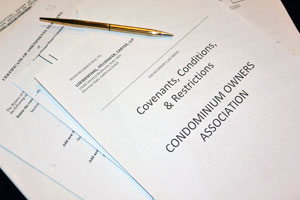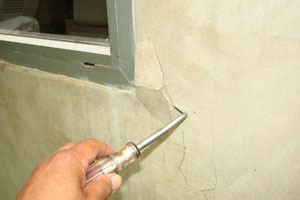It is almost commonplace at Association or Board of Director meetings for tempers to flare or emotions to run high, leading to very animated exchanges between members and members or members and directors. Some of these exchanges get downright nasty and personal, with all kinds of accusations being made during these emotionally charged meetings. For example:
Scenario 1. At open Association meetings, an angry member who doesn’t want to pay an increase in assessments or perform deferred maintenance at substantial costs necessitating a special assessment repeatedly accuses the Association and Board of Directors of being “crooks” and embezzling Association funds. Based on these accusations that a crime was committed, the Association and Directors sue the accusing member for defamation of character. Sound familiar?
Scenario 2. An Association denies a member’s architectural application and a lengthy dispute ensues. During the dispute, the homeowner, who just happens to be an attorney, accuses the Board of applying the Association’s architectural guidelines in a biased and discriminatory way. The Association’s attorney writes a letter to the owner, accusing the owner of engaging in “reprehensible” conduct and violating State Bar rules by failing to disclose the fact that he is an attorney by trade. The Owner sues the Association for libel. This is a true case…we don’t make these up!
When an association, manager, or homeowner becomes a defendant in a lawsuit, even a purely frivolous action can take painfully long to resolve. California law gives few, if any, avenues for prompt judicial review. However, there is a powerful procedural tool that is not often used or fully understood in the context of free speech disputes with HOA’s. In appropriate instances, the anti-SLAPP statute (Code of Civil Procedure §425.16) can result in a nearly immediate dismissal of a lawsuit and mandatory reimbursement of attorneys fees and costs to the prevailing party. It is only in the last few years that California Courts have begun considering the application of this important “shield” in the context of community association law.
The California legislature enacted the anti-SLAPP statute (SLAPP = Strategic Litigation Against Public Participation) to provide a quick and efficient remedy for to terminate meritless lawsuits brought to “chill” the exercise of First Amendment rights very early on. The statute is designed to protect “acts in furtherance of a person’s right of petition or free speech,” which includes the right to make statements in a “public forum” and in connection with an issue of “public interest.” If a person is sued for statements made in connection with a government proceeding, for example, the statements automatically qualify as protected “acts”. Because association meetings are considered “public forums,” the statute can sometimes offer relief to defendants in community association lawsuits.
In Scenario No. 1 above, if the court agrees that the accusatory statements were made at open board meetings (“public forum”) and would be of concern to the entire membership (“public interest”), then the burden is placed on the Association to immediately prove that no funds were in fact embezzled. If the Association cannot immediately provide evidence that embezzlement did not occur, the defamation suit will be dismissed and the Association will be ordered to pay the Owner’s attorney’s fees and costs.
In Scenario No. 2 above, because even private letters such as the one from the HOA’s attorney can be protected by the anti-SLAPP statute if they relate to an issue of interest to all members of the Association, a California court could find that the letters written by the Association’s attorney constitute protected speech. If the court makes that finding, the burden then immediately shifts to the owner to prove that the statements contained in the offending letters are truly defamatory (damaging to reputation) and more than mere hyperbole or figurative statements. Unless the owner can show a probability of winning at time of trial, a court may immediately dismiss the lawsuit and allow the Association to recover its attorney’s fees and costs.
Under normal circumstances, a Plaintiff has ample time and opportunity to gather evidence to prove his case at trial through investigation, depositions, written discovery, and other methods. The anti-SLAPP statute greatly accelerates this process and forces the Plaintiff to gather enough evidence to prove his case within two months of the initial service of the lawsuit. Thus, cases that lack merit can be adjudicated in a matter of months as opposed to years.
California courts have held that a community association is considered a “quasi-government entity” and functions “as a second municipal government,”1 meeting the “public forum” requirement of the statute. Two California cases, decided by the same court of appeal, extend this protection to the community association realm. In Ruiz v. Harbor View Community Association[i], it was held that even statements in private letters and conversations between a member and a Board of Directors may be protected. The Ruiz case involved a lengthy dispute over the rejection of an architectural submission that included claims of discriminatory or unequal application of the CC&R’s and an alleged conspiracy, resulting in a defamation lawsuit against the Association. Plaintiff’s colorful allegations took the Association’s conduct beyond mere “mundane communications” to become a matter of public interest (interest to all members of the Association).
Later, the same Court decided Turner v. Vista Pointe Ridge Homeowners Association[ii], which limited applicability of the anti-SLAPP statute to ensure that it could not be used to defeat all community association lawsuits. Because Turner involved only a “mundane communication (rejection of architectural application) between a member and his Association,” it did not involve an ‘issue of public interest,’ and the lawsuit was allowed to proceed. However, if Turner involved allegations of preferential treatment, or uneven application of governing documents, it may have resulted in a dismissal of the lawsuit as in the Ruiz case.
Our office has just successfully extended the anti-SLAPP protection to apply to repeated complaints by an association member against another member. In our case, the defendant was sued by the plaintiff for making numerous complaints to the Association and the City against the plaintiff over the course of several years. The complaining defendant was sued for, among other things, intentional and negligent infliction of emotional distress, invasion of privacy, and other serious torts.
Because the lawsuit alleged a fanciful story of conspiracies and malicious plots to force Plaintiff out of the community, the Plaintiff’s attorney unknowingly helped to ensure a finding that the homeowner complaints related to “a matter of public interest” that was protected by the anti-SLAPP statute. Thus, in the anti-SLAPP context, the exaggerated and colorful language often found in civil complaints can actually be turned around and used to a defendant’s benefit.
Because our client’s complaints and statements at board meetings and in letters were protected by the anti-SLAPP statute, and because the Plaintiff could not provide admissible evidence to prove the truth of his claims , the Court dismissed the action and awarded attorney’s fees to our client less than two months after the lawsuit was initially served.
As there is still no appellate case that specifically deals with the anti-SLAPP statute in the context of a homeowner suing another homeowner, this area of law will continue to evolve. However, as it now stands, any community association lawsuit should be immediately analyzed to see if the protections offered by the anti-SLAPP statute can result in a virtually immediate dismissal and reimbursement of attorney’s fees.


